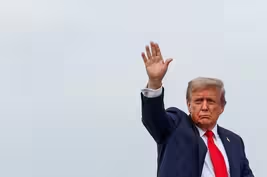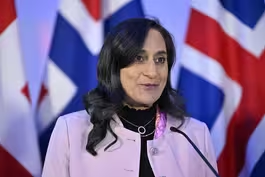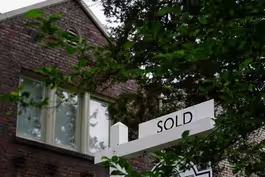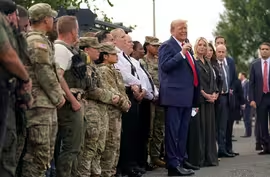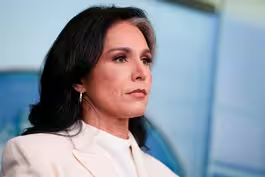
Tour of giant fantastic animals celebrates art of Oaxaca
Clip: 8/21/2025 | 5m 20sVideo has Closed Captions
Tour of giant, brightly colored creatures celebrates artistic heritage of Oaxaca
They’re called fantastic animals, brightly colored wooden creatures inspired by the world of Mexican magical realism. Giant versions of these animals are on a tour across the U.S., celebrating Mexico’s rich cultural heritage and promoting diplomacy during a contentious time. Senior arts correspondent Jeffrey Brown checked them out in San Francisco for our arts and culture series, CANVAS.
Problems playing video? | Closed Captioning Feedback
Problems playing video? | Closed Captioning Feedback
Major corporate funding for the PBS News Hour is provided by BDO, BNSF, Consumer Cellular, American Cruise Lines, and Raymond James. Funding for the PBS NewsHour Weekend is provided by...

Tour of giant fantastic animals celebrates art of Oaxaca
Clip: 8/21/2025 | 5m 20sVideo has Closed Captions
They’re called fantastic animals, brightly colored wooden creatures inspired by the world of Mexican magical realism. Giant versions of these animals are on a tour across the U.S., celebrating Mexico’s rich cultural heritage and promoting diplomacy during a contentious time. Senior arts correspondent Jeffrey Brown checked them out in San Francisco for our arts and culture series, CANVAS.
Problems playing video? | Closed Captioning Feedback
How to Watch PBS News Hour
PBS News Hour is available to stream on pbs.org and the free PBS App, available on iPhone, Apple TV, Android TV, Android smartphones, Amazon Fire TV, Amazon Fire Tablet, Roku, Samsung Smart TV, and Vizio.
Providing Support for PBS.org
Learn Moreabout PBS online sponsorshipAMNA NAWAZ: They're called fantastic animals,## brightly colored wooden creatures inspired# by the world of Mexican magical realism.
Now giant versions of these animals are on# a tour across the U.S., celebrating Mexico's## rich cultural heritage and promoting diplomacy# during contentious times in U.S.-Mexico relations.
Senior arts correspondent Jeffrey Brown checked## them out in San Francisco for our# arts and culture series, Canvas.
JEFFREY BROWN: At around 20 feet# high, they are hard to miss,## brightly colored and intricately designed weighing# over 1,200 pounds each, alebrijes and nahuales,## so-called fantastic animals, that have# their roots in Oaxaca and Mexico City and## were on display at the Yerba Buena Gardens in San# Francisco when we saw them earlier this summer.
EFRAIN FUENTES, Woodcarver# (through translator): For us,## it represents our .. JEFFREY BROWN: Efrain Fuentes is# a third-generation woodcarver who## began carving as a young boy in Oaxaca.
EFRAIN FUENTES (through translator):# I learned from my father.
Now I teach## my kids.
They are all grown,# so they're fourth generation.
JEFFREY BROWN: He's the artist behind# one of the nahuales, the coyote,## crafting a smaller version,# then working with a specialized## workshop in Mexico City to make the# grander versions that are on tour.
EFRAIN FUENTES (through translator): We as# artisans made the pieces in a small format,## about 60 centimeters or so.
We carved and painted# it in a special way to eventually make them big.
JEFFREY BROWN: Indigenous artists like Fuentes# rely on cultural tourism to make ends meet.## This kind of exhibition is a rare chance for# their work to be seen on a monumental scale.
ROMAIN GRECO, Project Director, Alebrijes# and Nahuales: I wanted to pay credit and to## pay tribute to the roots of all this art,# which is a popular art, traditional art.
JEFFREY BROWN: Romain Greco, an# arts presenter and producer based## in Mexico City, helped bring the project to life.
ROMAIN GRECO: The craftspeople and these people,# which are artists in my point of view, are not## so much concerned about showing their work.
They# just want to sell their work and live on a daily## basis.
But I think that it's important for the# people to understand the richness of the work.
So, by blowing them, and we make people aware of# the artistic value of these pieces, putting them## at the site of everybody in the context of a urban# architecture.
I think they take all their power.
JEFFREY BROWN: So, it should be seen as a# traditional art form, but now made contemporary?
ROMAIN GRECO: Yes, exactly.# That's exactly what I want to do.
JEFFREY BROWN: Indeed, Carlomagno Pedro Martinez,# director of the Museum of Popular Art in Oaxaca,## who curated the exhibit, says it's important to# understand this work in terms of contemporary art.
CARLOMAGNO PEDRO MARTINEZ, Curator,# Alebrijes and Nahuales (through translator):## There has always been controversy if folk art or# handicrafts is different from contemporary art,## but this art that is presented is# contemporary art, without a doubt,## and the people who are producing it# are artists with all the breadth of## the word.
This is contemporary art from# the indigenous communities of Oaxaca.
JEFFREY BROWN: Also important, he says,# bringing the art of indigenous artists## to a U.S. audience at this particularly# tense moment in U.S.-Mexican relations,## especially over tariffs and immigration,# including protests against ICE raids.
CARLOMAGNO PEDRO MARTINEZ (through translator):# Art is the universal language of humanity,## and amid political and economic tensions# that exist between our countries,## art is the beautiful face of humanity.
It is# the universal message that we humans give,## and this is where there is a# fraternal bond between peoples.
JEFFREY BROWN: Romain Greco# describes it as soft power.
ROMAIN GRECO: It's very important to# use art as a diplomacy instrument,## because sometimes politics can be complicated and# can be tricky, but art is much more universal.
JEFFREY BROWN: Ken Bukowski is the chair of# the board of the Yerba Buena Conservancy,## which oversees the gardens.
For you, does it have an extra urgency now?
KEN BUKOWSKI, Chair, Yerba Buena Gardens# Conservancy: I think it has an extra urgency,## because it just is one more way to# show that level of respect, where maybe## people from Mexican ancestry aren't getting# their respect throughout the rest of the## country and with the politics going on now.
But,# here in San Francisco, we do value that history,## we do value that culture, and we want# to show that by showing this art.
JEFFREY BROWN: The eight-piece# sculptural installation has now## moved on to a national tour in# public spaces across the country,## Nevada and California this year,# moving farther east in 2026 and 2027.
For the "PBS News Hour," I'm# Jeffrey Brown in San Francisco.
Appeals court dismisses $500M fraud penalty against Trump
Video has Closed Captions
Clip: 8/21/2025 | 7m 56s | New York appeals court throws out $500M fraud penalty against Trump (7m 56s)
Canada's foreign minister on the future of U.S. relations
Video has Closed Captions
Clip: 8/21/2025 | 9m 8s | Canada's foreign minister on U.S. relations and security guarantees for Ukraine (9m 8s)
July home sales up, offering momentum to struggling market
Video has Closed Captions
Clip: 8/21/2025 | 5m 46s | Home sales went up in July, offering momentum to a struggling market (5m 46s)
News Wrap: Trump greets National Guard troops in D.C.
Video has Closed Captions
Clip: 8/21/2025 | 10m 25s | News Wrap: Trump greets law enforcement and National Guard troops patrolling D.C. (10m 25s)
What Gabbard's ODNI cuts mean for U.S. intelligence agencies
Video has Closed Captions
Clip: 8/21/2025 | 7m 31s | What Gabbard's ODNI cuts mean for U.S. intelligence agencies (7m 31s)
Why the federal government could take a stake in Intel
Video has Closed Captions
Clip: 8/21/2025 | 6m 28s | Why the federal government could take a stake in Intel (6m 28s)
Providing Support for PBS.org
Learn Moreabout PBS online sponsorship
- News and Public Affairs

FRONTLINE is investigative journalism that questions, explains and changes our world.

- News and Public Affairs

Amanpour and Company features conversations with leaders and decision makers.












Support for PBS provided by:
Major corporate funding for the PBS News Hour is provided by BDO, BNSF, Consumer Cellular, American Cruise Lines, and Raymond James. Funding for the PBS NewsHour Weekend is provided by...
